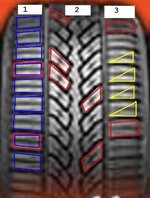Below is a picture of a tire with three different types of wear patterns indicated. The areas marked 1 and 3 are most proned to show wear caused by toe and camber. The difference is in the manor in which the wear developes. Under area one you will see blue sections around the tread. This marking is supposed to represent an even wearing of the entire section of tread only on this side of the tire. This would be an indication of excessive camber. If the area marked 1 is the side closest to the car then it's considered to have excessive negative camber. If area 1 is on the outside of the vehicle then there is excessive positive camber.
The tread wear in area 3 that is yellow indicates excessive toe wear. This can be negative or positive as well. The difference is that instead of wearing out the entire patch like the blue, it wears it so that the straight line on the bottom is raised higher than the top section. In essence, if you start at the bottom of the tread and run your hand up the tire, the tread will cut in to your hand. If you start at the top and come down then it is smooth.
If you have wear that developes similar to the read areas then your tires could be out of balance, there could be a seperated belt inside the tire or other suspension components could be worn out causing abnormal and random tire wear.
If areas 1 and 3 are the only areas that are worn and the wear is similar to the blue areas only in both 1 and 3 then you have one of two problems. One is the tire pressure is too low and the center of the tire is not being used enough OR the tire has been on the front of the vehicle for too long.
On front wheel drive vehicles and cars that primarily front wheel drive with the option of awd (like the DSM's) the tire leans as the steering wheel is turned. This causes the contact patch of the tire to change. Much like a motorcyclist leaning in to a turn so does the wheel on the front. As the vehicle turns left, the top of the left tire leans outward and the right leans inboard causing the outer edge to be used more on the left tire and the inner edge to be used more on the right tire.. As the car turns right, the wear patterns reverse. So leaving a tire up front for it's entire life will cause it to wear out much more than the rear.
The rear tires do not lean at all on the DSMs unless the vehicle has excessive camber. As such, the rear tires not only wear less on the outer edges, but they also wear less throughout the entire surface of the tire. Less wear means longer life and less need for constant balancing. However, these rear tires should not be neglected and really should be rotated to reduce abnormal wear on the front.
If the tire wear is only in the middle then the tires have either been spun alot or the tire pressure is too high.
Doug
The tread wear in area 3 that is yellow indicates excessive toe wear. This can be negative or positive as well. The difference is that instead of wearing out the entire patch like the blue, it wears it so that the straight line on the bottom is raised higher than the top section. In essence, if you start at the bottom of the tread and run your hand up the tire, the tread will cut in to your hand. If you start at the top and come down then it is smooth.
If you have wear that developes similar to the read areas then your tires could be out of balance, there could be a seperated belt inside the tire or other suspension components could be worn out causing abnormal and random tire wear.
If areas 1 and 3 are the only areas that are worn and the wear is similar to the blue areas only in both 1 and 3 then you have one of two problems. One is the tire pressure is too low and the center of the tire is not being used enough OR the tire has been on the front of the vehicle for too long.
On front wheel drive vehicles and cars that primarily front wheel drive with the option of awd (like the DSM's) the tire leans as the steering wheel is turned. This causes the contact patch of the tire to change. Much like a motorcyclist leaning in to a turn so does the wheel on the front. As the vehicle turns left, the top of the left tire leans outward and the right leans inboard causing the outer edge to be used more on the left tire and the inner edge to be used more on the right tire.. As the car turns right, the wear patterns reverse. So leaving a tire up front for it's entire life will cause it to wear out much more than the rear.
The rear tires do not lean at all on the DSMs unless the vehicle has excessive camber. As such, the rear tires not only wear less on the outer edges, but they also wear less throughout the entire surface of the tire. Less wear means longer life and less need for constant balancing. However, these rear tires should not be neglected and really should be rotated to reduce abnormal wear on the front.
If the tire wear is only in the middle then the tires have either been spun alot or the tire pressure is too high.
Doug

















